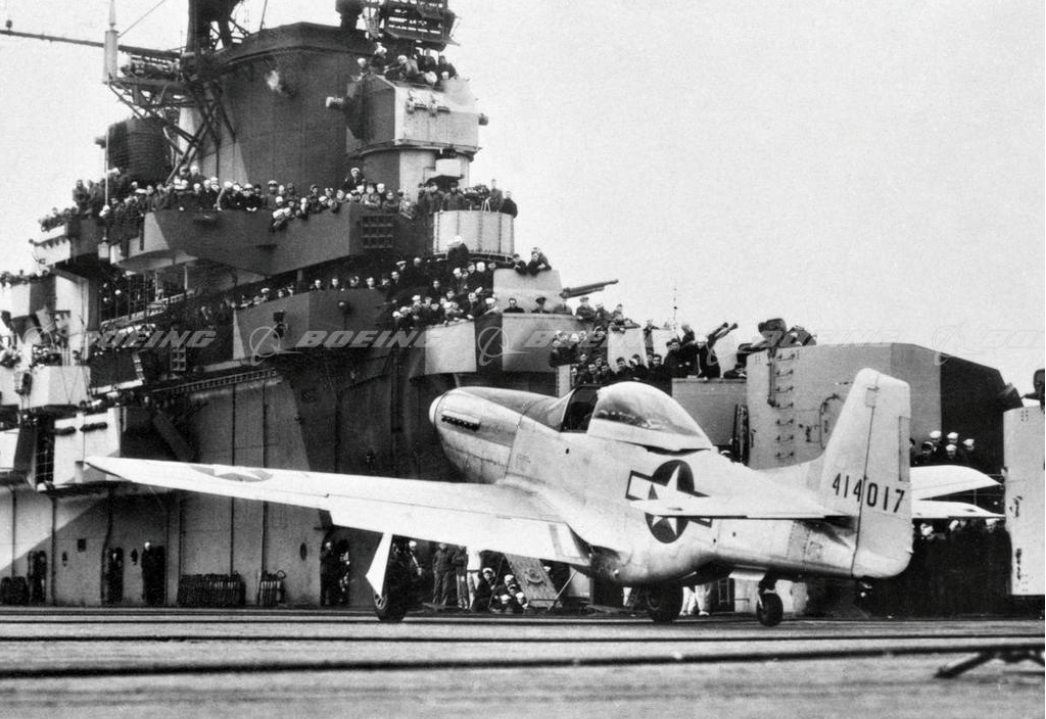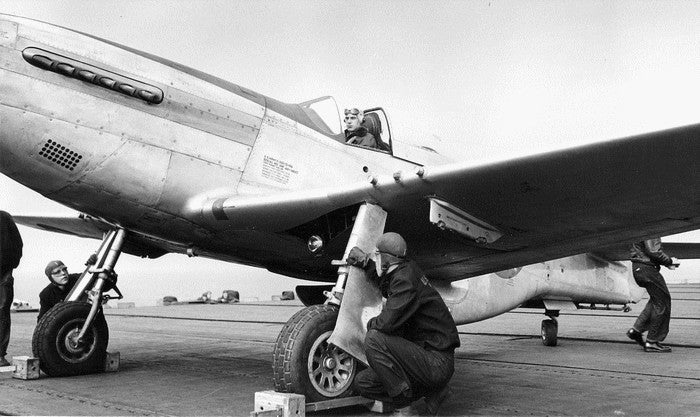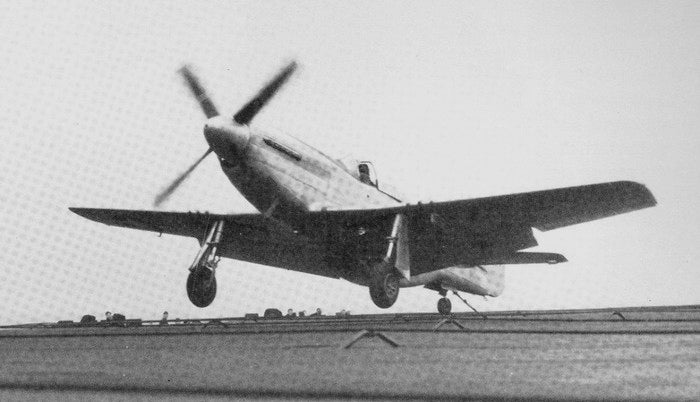 "ttyymmnn" (ttyymmnn)
"ttyymmnn" (ttyymmnn)
10/26/2018 at 10:12 • Filed to: wingspan, Planelopnik
 6
6
 6
6
 "ttyymmnn" (ttyymmnn)
"ttyymmnn" (ttyymmnn)
10/26/2018 at 10:12 • Filed to: wingspan, Planelopnik |  6 6
|  6 6 |
 !!!CAPTION ERROR: MAY BE MULTI-LINE OR CONTAIN LINK!!!
!!!CAPTION ERROR: MAY BE MULTI-LINE OR CONTAIN LINK!!!
By 1943, the US Army Air Forces were bombing Japan with long-range B-29 bombers, but they (and the US Navy) lacked a suitable escort fighter with range to accompany the bombers. The P-51 Mustang had proven itself in the skies over Europe, and the classified Project Seahorse sought to test the feasibility of flying Mustangs from US Navy carriers sailing closer to Japan. A single P-51 was modified for carrier operations by strengthening the landing gear and fuselage and adding an arrestor hook. US Navy test pilot Lieutenant Robert M. Elder made 25 landings and takeoffs on the carrier USS Shangri-La with the redesignated ETF-51D* and, though the maritime Mustang proved capable of fulfilling the role, the capture of the islands of Okinawa and Iwo Jima in early 1945 removed the need for the Mustang as an escort in the Pacific and the project was shelved.

US Navy

(US Navy)
*Sources differ on whether or not the modified Mustang was actually redesignated ETF-51. The prefix change from P (Pursuit) to F (Fighter) did not occur until 1948, so the designation ETF-51 may have been applied after the war, long after the carrier testing program had finished.
!!! UNKNOWN CONTENT TYPE !!!
For more posts about airplanes, aviation history and aircraft oddities, head over to
!!!error: Indecipherable SUB-paragraph formatting!!!
.
!!! UNKNOWN CONTENT TYPE !!!
 Ash78, voting early and often
> ttyymmnn
Ash78, voting early and often
> ttyymmnn
10/26/2018 at 10:45 |
|
Actual backstory: When the Geneva Convention heard we were sending Mustangs to Japan, they said there is no way we would be allowed to cause so many civilian casualties and they canceled the plan.
/memed
 facw
> ttyymmnn
facw
> ttyymmnn
10/26/2018 at 10:54 |
|
I really hate that Boeing does that stupid watermark thing. I mean are there people out there licensing Boeing’s photo library? It gives them a bit more control, but it’s really tough to see what people would do with these photos that would be at all damaging to Boeing.
 ttyymmnn
> facw
ttyymmnn
> facw
10/26/2018 at 10:57 |
|
I have to wonder if that photo really does belong to Boeing. U nless it was snapped by a North American employee, it was almost certainly taken by a Navy photographer Alamy is even worse. They take historical photos that could only have been snapped by members of the military, or are public domain, and slap their watermark on it.
 user314
> ttyymmnn
user314
> ttyymmnn
10/26/2018 at 11:00 |
|
I was curious about that designation, and went Googling. Turns out there’s a bit of confusion out there regarding Project Seahorse:
“There is also some confusion I believe over the name of the aircraft. Some resources call the Naval-modified P-51D an “ETF-51D”, but this isn’t correct. The aircraft never had a change of name while it was in the hands of the Navy (not even a BuNo assigned to it), and if it had, it wouldn’t have been in that form, for a North American product in U.S. Navy hands would have had a “J” in the title. The term “ETF-51D” came later, in the post-war years, with the NACA operated F-51D’s. “ET” was added to the front of the title, meaning “Extended Tail”, as NACA added taller tail fin caps to their F-51D’s (which Cavalier later copied and used in their Mustang conversions). There is the possibility that this particular airframe, 44-14017, was handed over to the NACA after the carrier trials, and later became an “ETF-51D” in the hands of the NACA.”
P-51D-5-NA 44-14017 was handed over to the NACA following the November 1944 carrier trials, and it became NACA 102. The “ETF-51D” term applied to the NACA Mustangs when they re-entered USAF inventory with the Air Guard in the early 50's. The often-quoted Gaëtan Marie article about the Naval Mustangs is incorrect in stating that the Navy re-named/changed the terminology of 44-14017 to anything other than P-51D. At the time, there was no such thing as an F-51D, a TF-51D, or an ETF-51D, all of which was post-1947 era USAF terminology, and the furthest thing from how the Navy came up with the terminology for their aircraft - had the Navy actually re-named the aircraft (which would also have to mean that it would have entered their service with a BuNo, which it never did), it would have been the aircraft called an FJ-1.
!!!error: Indecipherable SUB-paragraph formatting!!!
http://www.warbirdinformationexchange.org/phpBB3/viewtopic.php?f=3&t=65902&mobile=off
 ttyymmnn
> user314
ttyymmnn
> user314
10/26/2018 at 11:04 |
|
Interesting. I did, in fact, reference that Gaetan Marie article , but Boeing also calls it the ETF-51 in the article where I found the top photograph. I will say, though, that I was a bit confused by the F, since the F-51 designation was definitely a postwar change.
 Urambo Tauro
> ttyymmnn
Urambo Tauro
> ttyymmnn
10/26/2018 at 11:49 |
|
I’m sure that arrestor hook prevented many Carriers & Co ffee incidents.